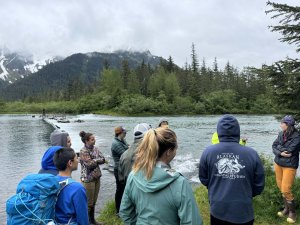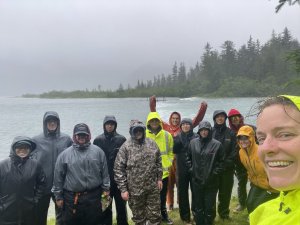Fish Passage Restoration Site Fields Trips

CCE group visiting the Eyak Lake Weir in Cordova.
Copper River Delta and Copper Basin Fish Passage Restoration Site Field Trips
Active culvert construction provided awesome hands-on outreach experiences for multiple outreach programs on the Copper River Delta and in the Copper Basin. In June, CRWP Staff led the Community Coastal Experience program interns on an in-depth outing to explore jobs and gain hands-on experience using skills needed to implement fish passage and monitor restoration efforts.
After visiting the construction site in motion, participants helped to conduct post-restoration monitoring at one of the culverts completed last year. They learned how to check minnow traps and identify local fish species, as well as how to survey culverts with support from our awesome partners from the U.S. Fish and Wildlife Service.

T3 Alliance visiting culvert sites in Cordova.
Later in July, a group of high school students or recent graduates known as T3 Alliance, hosted by the University of Alaska Fairbanks, visited Cordova to learn more about mariculture and salmon fisheries. Program Director Kate Morse took the group to visit the active construction site as well as a culvert under design and a culvert recently restored. These outings provided real-world applications for math, engineering, and science to help the participants in both programs learn more about careers that could lead them to work on fish passage projects; from engineering to construction to habitat monitoring, it takes a diverse skill set to make these projects successful.
 The Copper River Native Association (CRNA) in the Copper Basin invited our Watershed Stewardship Program Manager, Amanda Jackson, to work with students during Salmon Education Week in late July. Students tested their knowledge on topics such as components of a watershed, the salmon life cycle throughout the watershed, and the human impact within the watershed. Amanda presented an overview of how CRWP collaborates with partners to restore fish habitat by installing fish-friendly culverts and showed students a time-lapse video of the COP 33 culvert installation last summer. The students played a salmon stream simulation game that involved barriers they might experience within the watershed while “carrying their eggs.” The following day a group of student reenacted the salmon simulation game in the water in a local stream.
The Copper River Native Association (CRNA) in the Copper Basin invited our Watershed Stewardship Program Manager, Amanda Jackson, to work with students during Salmon Education Week in late July. Students tested their knowledge on topics such as components of a watershed, the salmon life cycle throughout the watershed, and the human impact within the watershed. Amanda presented an overview of how CRWP collaborates with partners to restore fish habitat by installing fish-friendly culverts and showed students a time-lapse video of the COP 33 culvert installation last summer. The students played a salmon stream simulation game that involved barriers they might experience within the watershed while “carrying their eggs.” The following day a group of student reenacted the salmon simulation game in the water in a local stream.
Find more information on our Watershed Education Programs here, and on our Fish Passage Projects here.


